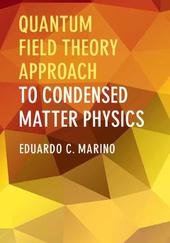
|
Quantum Field Theory Approach to Condensed Matter Physics
Hardback
Main Details
| Title |
Quantum Field Theory Approach to Condensed Matter Physics
|
| Authors and Contributors |
By (author) Eduardo C. Marino
|
| Physical Properties |
| Format:Hardback | | Pages:532 | | Dimensions(mm): Height 253,Width 178 |
|
| Category/Genre | Quantum physics |
|---|
| ISBN/Barcode |
9781107074118
|
| Classifications | Dewey:530.41 |
|---|
| Audience | | Professional & Vocational | |
|---|
| Illustrations |
24 Halftones, black and white; 84 Line drawings, black and white
|
|
Publishing Details |
| Publisher |
Cambridge University Press
|
| Imprint |
Cambridge University Press
|
| Publication Date |
28 September 2017 |
| Publication Country |
United Kingdom
|
Description
A balanced combination of introductory and advanced topics provides a new and unique perspective on the quantum field theory approach to condensed matter physics. Beginning with the basics of these subjects, such as static and vibrating lattices, independent and interacting electrons, the functional formulation for fields and different generating functionals and their roles, this book presents a unified viewpoint illustrating the connections and relationships among various physical concepts and mechanisms. Advanced and newer topics bring the book up to date with current developments and include sections on cuprate and pnictide superconductors, graphene, Weyl semimetals, transition metal dichalcogenides and topological insulators. Finally, well-known subjects such as the quantum Hall effect, superconductivity, Mott and Anderson insulators, and the Anderson-Higgs mechanism are examined within a unifying QFT-CMP approach. Presenting new insights on traditional topics, this text allows graduate students and researchers to master the proper theoretical tools required in a variety of condensed matter physics systems.
Author Biography
Eduardo C. Marino is Professor of Physics at the Universidade Federal do Rio de Janeiro. He is an elected member of the Brazilian National Academy of Sciences, and in 2005 was awarded the National Order of the Scientific Merit by the president of Brazil.
Reviews'Quantum field theory and condensed matter physics have mutually benefited from the progress in their respective areas. Recently some authors have been working to provide a unified view of these fields, both conceptually and in their technical aspects. Eduardo C. Marino's book is an important step in this direction and it is bold in its outlook as it deals with problems that have no consensual solution yet in the scientific community. In these chapters Marino is especially inspired as he guides the reader firmly through the challenges presented by these problems. His approach leads to a powerful grasp of mathematical tools and a solid knowledge of the most actual problems in condensed matter physics.' Mucio Amado Continentino, Centro Brasileiro de Pesquisas Fisicas, Brazil 'This book explains how one can use Quantum Field Theory (QFT) to analyze Condensed Matter Physics and as a result it comprises three main parts which are respectively (I) condensed matter physics, (II) quantum field theory and (III) quantum field theory approach in condensed matter systems. The book is bulky, but if you have the basis, only the basis, background of the mathematical machinery of quantum mechanics, you will read it easily. ... The number of topics so considered is rather large enough to include, for instance, Fermi liquids and Anderson insulators, polarons, polyacetylene, quantum magnets in 1D and in 2D, spin-fermion system, spin glass, superfluidity, superconductivity, pnictides,graphene, silicenes, insulators quantum, quantum computation. ... I used to give these books-for-review as a gift to the library of my university, but I decided to keep the present one for my own personal library.' Guy Jumarie, Zentralblatt MATH 'This book provides an excellent overview of the state of the art of quantum field theory (QFT) applications to condensed-matter physics (CMP). ... I would keenly recommend this to advanced graduate students and researchers in the field, who will find, in part three, plenty of hot topics that are very well explained and accompanied by complete references.' Rogelio Palomo, CERN Courier 'Students in particular would welcome seeing how the 'new' formalism can be matched with an 'old' one ... this is a useful book to have in one's library.' Malte Henkel, Acta Crystallographica Section A
|